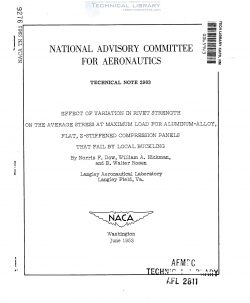naca-tn-2963
- Version
- 170 Downloads
- 530.82 KB File Size
- 1 File Count
- January 20, 2017 Create Date
- January 20, 2017 Last Updated
National Advisory Committee for Aeronautics, Technical Notes - Effect of Variation in Rivet Strength on the Average Stress at Maximum Load for Aluminum Alloy, Flat, Z-Stiffened Compression Panels that Fail by Local Buckling

A study is made of the effect of variation in rivet strength on the
average panel stress at maximum load for 75S-T6 aluminum-alloy, flat,
Z-stiffened compression panels that fail by local buckling. A curve is
presented for the determination of the relationship between strength,
diameter, and pitch of the rivets, and the strength of stiffened, flat
compression panels of such proportions that failure is by local buckling.
The effect on the strength of longitudinally stiffened compression
panels of the riveting used to attach stiffeners to skin has been exten-
sively investigated at the Langley structures research laboratory of the
National Advisory Committee for Aeronautics. Comprehensive test data
have been presented on the strength of Bus-T3 aluminum—alloy panels
assembled with Al7S-Th aluminum-alloy rivets at various combinations of
rivet pitch and diameter (refs. 1 to 5), and the test program has been
extended (ref. 6) to include YES—T6 aluminum-alloy panels of similar
dimensions. Reference 6 presents a curve for the determination of the
stress at maximum load for aluminum—alloy panels, having extruded,
Z—section stiffeners attached to the skin with Al7S-TA aluminum-alloy
rivets at various combinations of rivet diameter and pitch.
The phase of the investigation reported herein is an extension of
the previous work to include the effect of rivet strength, in addition
to size and spacing, and thereby to adapt the previous data for use with
rivets of any kind.
All the test specimens were 758-T6 aluminum-alloy panels having
longitudinal, extruded, Z—section stiffeners and the dimensions shown
in figure 1. The length of the panels (L/p = 20) was chosen to avoid
column-bending type of failures. The test panels were assembled with
universal head (ANkYO) or Cherry blind type (ANh63) rivets and seven
different rivet materials were investigated. The rivet materials used
were 28, 538, A178, and 2#S aluminum alloys, FS—l magnesium alloy,
beryllium-copper, and Mbnel metal. The Cherry blind rivets had Al7S-Th
shanks and lYS—Th mandrils. Rivet diameters and pitches were varied as
in previous investigations (refs. 1 to 6).
| File | Action |
|---|---|
| naca-tn-2963 Effect of Variation in Rivet Strength on the Average Stress at Maximum Load for Aluminum Alloy, Flat,.pdf | Download |
Comment On This Post